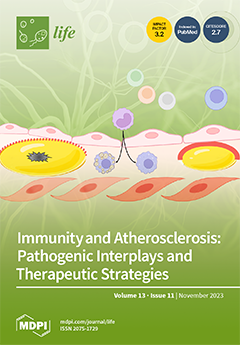Objectives:
H. pylori-associated dyslipidemia has been reported to be a major risk factor for atherosclerosis and coronary heart diseases. We aimed to investigate the association of the
H. pylori infection with dyslipidemia. Methods: A retrospective case–control study was undertaken to evaluate
H. pylori-associated dyslipidemia, where
H. pylori-positive individuals were treated as the case group (
n = 260) while
H. pylori-negative individuals were considered as the control group (
n = 250). The mean ± SD of the age of the patients included (
n = 510) was 44.01 ± 13.58 years. Study subjects with a total cholesterol level of >5.17 mmol/L and/or a triglyceride level of >1.69 mmol/L and/or an LDL-C level of >2.59 mmol/L and/or an HDL-C level of <1 mmol/L in males and/or an HDL-C level of <1.3 mmol/L in females were defined as dyslipidemia. Descriptive (mean, standard deviation, median, and IQR) and inferential (
t-test, chi-square test, and logistic regression) statistical analyses were undertaken using the R-base/R-studio (v-4.0.2)/tidyverse package. Univariate and bivariate logistic regressions were executed to calculate the crude and adjusted odds ratio along with the
p-value. A
p-value of <0.05 was the cut-off for statistical significance. We used ggplot2 for data visualization. Results: The differences in overall mean ± SD (
H. pylori positive vs. negative) of the cholesterol (5.22 ± 1.0 vs. 5.49 ± 0.85,
p < 0.01), triglyceride (1.66 ± 0.75 vs. 1.29 ± 0.71,
p < 0.001), LDL-C (3.43 ± 0.74 vs. 3.26 ± 0.81,
p < 0.05), and HDL-C (1.15 ± 0.30 vs. 1.30 ± 0.25,
p < 0.001) levels were statistically significant. The cholesterol and LDL-C levels in ages >60, age = 30–60, in females, and LDL-C levels in males were not significantly different for the
H. pylori-positive and -negative groups. The proportion (
H. pylori positive vs. negative) of hypercholesterolemia (190/59.9% vs. 127/40%
p < 0.01), hypertriglyceridemia (136/68% vs. 64/32%
p < 0.001), high LDL-cholesterolemia levels (234/53% vs. 201/46%
p < 0.01), and low HDL-cholesterolemia levels (149/71% vs. 60/28.7%
p < 0.01) were statistically significant. The odds of having hypercholesterolemia (AOR: 2.64, 95%CI: 1.824–3.848,
p < 0.001), hypertriglyceridemia (AOR: 3.24, 95%CI: 2.227–4.757,
p < 0.001), an increased LDL-C level (AOR: 2.174, 95%CI: 1.309–3.684,
p < 0.01), and a decreased HDL-C level (AOR: 4.2, 95%CI: 2.937–6.321,
p < 0.001) were 2.64, 3.24, 2.17, and 4.2 times higher in the
H. pylori-infected individuals as compared with the
H. pylori-uninfected group. Conclusion: Our results demonstrate that an enhanced risk of dyslipidemia is associated with the
H. pylori infection, which can aggrandize the atherosclerosis process. The evaluation of temporal variation in the lipid profile in
H. pylori-infected individuals is recommended for the effective management of
H. pylori-infected patients.
Full article






